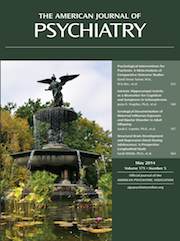Response to Tasca et al.
To the Editor: We thank Drs. Tasca, Hilsenroth, and Thompson-Brenner for their comments on our study. The letter gives us the opportunity, as the clinicians and researchers responsible for developing the psychoanalytic treatment and designing the randomized controlled trial, to emphasize that the psychoanalytic therapy employed in our trial is one particular version of psychodynamic psychotherapy. As we pointed out in the article, other psychodynamic approaches to the treatment of bulimia nervosa exist, and among these are treatments integrating more structured behavioral interventions directed specifically toward the core symptoms of bulimia nervosa (1). Thus, while our study does not support the efficacy of the specific version of psychoanalytic psychotherapy for bulimia nervosa used in the trial, in our opinion the obvious implication of the study is that a psychodynamic therapy with a more directive approach to the bulimic symptoms should be tested in future clinical trials. This would be in accordance with the continuous development and enhancement of cognitive-behavioral therapy (CBT) for bulimia through the previous decades.
In this sense, we fully agree with Tasca et al. that the approach toward symptoms recommended in our treatment guideline was not optimal. We do, however, want to stress that binging and purging was indeed addressed systematically in the psychoanalytic psychotherapy. In the treatment guideline, it is underscored that “the question of how to address the symptoms is an issue of particular importance,” and while we stated that a narrow focus on the behavioral symptoms might impede the process of psychoanalytic psychotherapy, we also pointed out that “it is the task of the therapist to get a picture of the frequency and intensity of the symptoms and to try to involve the patient in a mutual reflection upon the symptoms … as psychological phenomena carrying a meaning and function in the patient’s life” (2).
With regard to the criticism that the psychoanalytic psychotherapy used in the study is not a bona fide treatment practiced in the real world, we have found that this kind of treatment has been practiced relatively widely in Denmark and other European countries. Thus, in our opinion the finding that this is not a sufficiently efficacious approach is highly relevant to dynamically oriented practitioners.
Tasca et al. call attention to the Anorexia Nervosa Treatment of OutPatients (ANTOP) study (3), which demonstrated equivalent outcomes between psychodynamic therapy and CBT. While we agree that this study is highly important, the fact that the ANTOP study concerns the treatment of anorexia nervosa makes it hard to compare this study to ours. Anorexia and bulimia are indeed closely related disorders with many characteristics in common, but the treatments of the two disorders pose very different challenges. Perhaps most importantly, whereas patients with anorexia nervosa are typically highly ambivalent toward giving up the anorectic symptoms, patients with bulimia nervosa are more often motivated toward change and may be engaged in the directive behavioral approach of CBT more easily than patients with anorexia nervosa. Thus, we would caution against drawing too firm conclusions about the treatment of bulimia nervosa based on treatments of anorexia nervosa.
All in all, we sincerely hope that our study will give the impetus for further studies of psychodynamic psychotherapy for bulimia nervosa. We thank Drs. Tasca, Hilsenroth, and Thompson-Brenner for the suggestion to investigate the relationship between a focus on symptoms and improvement within and across treatments. Furthermore, we hope that when the results from our ongoing studies of patient attachment style and reflective functioning measured through the treatment are published, they will add to the understanding of the specific contributions of psychodynamic approaches to bulimia nervosa.
1 : The integration of psychodynamic and behavior therapy in the treatment of eating disorders: clinical issues versus theoretical mystique, in Psychodynamic Treatment of Anorexia Nervosa and Bulimia. Edited by Johnson CL. New York, Guilford Press, 1991, pp 374–397Google Scholar
2 : Psychoanalytic psychotherapy for bulimia nervosa: a manualized approach. Psychoanal Psychother 2012; 26:48–64Crossref, Google Scholar
3 ;



